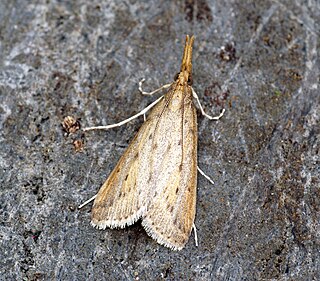
Schoenobius is a genus of moths of the family Crambidae and typical of the subfamily Schoenobiinae. Species are found mostly in Europe.

Scirpophaga is a genus of moths of the family Crambidae described by Georg Friedrich Treitschke in 1832. Asian species include significant rice stemborer pests.
Meganola brunellus is a moth of the family Nolidae. It is found in Sri Lanka, India, Taiwan, Japan, the Ryukyu Islands, Sundaland, Queensland and the Bismarck Islands. It is an introduced species in Hawaii.

Schoenobiinae is a subfamily of the lepidopteran family Crambidae. The subfamily was described by Philogène Auguste Joseph Duponchel in 1846.
Prionapteryx albicostalis is a moth in the family Crambidae. It was described by George Hampson in 1919. It is found in what was Madras State in India.
Prionapteryx arenalis is a moth in the family Crambidae. It was described by George Hampson in 1919. It is found in the Punjab region of what was British India.
Schoenobius endochalybella is a moth in the family Crambidae. It was described by George Hampson in 1896. It is found in Paraná, Brazil.
Schoenobius endochralis is a moth in the family Crambidae. It was described by George Hampson in 1919. It is found in Argentina.
Schoenobius irrorata is a moth in the family Crambidae. It was described by George Hampson in 1919. It is found in Paraná, Brazil.
Schoenobius retractalis is a moth in the family Crambidae. It was described by George Hampson in 1919. It is found in Guyana.
Schoenobius sagitella is a moth in the family Crambidae. It was described by George Hampson in 1896. It is found in Brazil.
Schoenobius vittatalis is a moth in the family Crambidae. It was described by George Hampson in 1919. It is found in São Paulo in Brazil and in Paraguay.
Schoenobius vittatus is a moth in the family Crambidae. It was described by Heinrich Benno Möschler in 1882. It is found in Suriname and Belize.
Patissa rufitinctalis is a moth in the family Crambidae. It was described by George Hampson in 1919. It is found in Sierra Leone.

Scoparia australiensis is a moth in the family Crambidae. It was described by George Hampson in 1899. It is found in Australia, where it has been recorded from Western Australia and Queensland.
Cynaeda leucopsumis is a moth in the family Crambidae. It was described by George Hampson in 1919. It is found in Assam, India.
Syllepte maculilinealis is a moth in the family Crambidae. It was described by George Hampson in 1918. It is found in Uganda.
Syllepte brunneiterminalis is a moth in the family Crambidae. It was described by George Hampson in 1918. It is found in Kenya and Nigeria.
Udeoides nigribasalis is a moth in the family Crambidae. It was described by George Hampson in 1913. It is found in Kenya.


